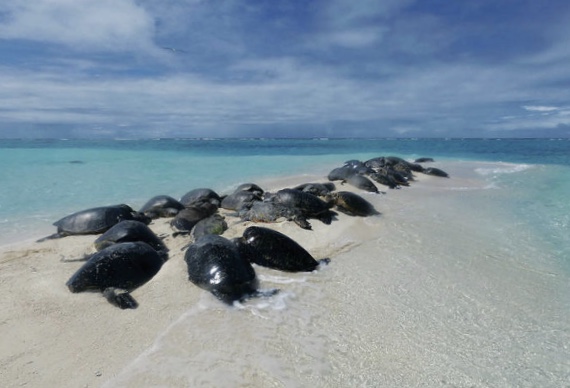
“You will have a lot of females wasting a lot of energy, digging down, and they will dig all night. And they will hit that hard pack, hit the bottom, and they’ll dig and they’ll dig and they’ll dig and eventually give up or lay a nest that’s going to fail,” said Charles Littnan, director of the Pacific Islands Fisheries ScienceCenter’s protected species division, at the Land Board’s January 24 meeting.
Littnan was describing one of the new hurdles threatened Hawaiian green sea turtles at Tern Island face following Hurricane Walaka, which swept through French Frigate Shoals in the Northwestern Hawaiian Islands in 2018. The hurricane left the island with shallower sand deposits than the turtles require for successful nests.
Over the course of two meetings last month, researchers who have received permits to access the Papahanaumokuakea Marine National Monument briefed the Land Board on their work over the years.
Littnan reported on the turtles’ challenges during the first full nesting season, post-Walaka.
French Frigate Shoals is where 96 percent of Hawaiian green sea turtles nest, and the storm devastated the small islets there, wiping out East Island altogether. But by the next year, East Island had reemerged and sand had also accreted at Tern Island, another popular nesting site. Littnan said that this past season, about 263 green sea turtles nested at Tern and 106 nested at East. In the past, about 500 turtles would nest at East.
With regard to the sand restoration at Tern, “initially, it looks great. There’s more habitat for turtles and you had more animals that were nesting there,” Littnan said. However, a lot of that habitat was, in his words, junk.
Before the hurricane, most of the turtles nested along a line of vegetation on the island. The area was flat, with deep sand. The storm ripped out most of that vegetation, and the layer of sand that later accreted was no more than ten inches deep.
With their preferred nesting area gone, the turtles ventured to other parts of the island and many got trapped behind dilapidated seawalls, he continued. (Decades ago, the island was a naval base and, later, a U.S. Coast Guard station.)
“We were removing at least two turtles per week from behind seawalls and some of these were massive females that take five or six people to move,” Littnan said.
By the end of the season, there were a lot of nests, but very few that hatched, he said.
The problems seen on East Island were slightly different. The island used to be the top nesting site for the turtles, according to Littnan, and while it reemerged, “it’s still not anywhere near what it was.” As a result, carrying capacity is now an issue. Land Board members exclaimed, “Whoa,” and “Hoo!” upon seeing photos of just how many turtles were trying to nest on the small island.
Littnan said that the problem is that early nesters will lay eggs that will simply be dug up by the next wave of nesters.
If the habitat is of similar poor quality to that of Tern, that will just make matters worse. “They can dig down 15-20 inches, but they’re digging into the water table. … Of the successful nests they think were laid, a lot were wave-washed or inundated by sea water,” he said.
He added that counting the number of turtle nests was how his agency monitored the turtle population. With so many nests now possibly being unsuccessful, it may need to find another way to estimate the population, he said.
One bright spot: Scientists documented significant nesting activity at Lisianski, which is one of the more northern islands in the archipelago. Although the turtles probably nested there historically, it hadn’t been documented before. “Hopefully, they’re reestablishing themselves for a little more resiliency,” he said.
Littnan said it will likely take two to three years to understand the impacts Walaka had on the turtles and monk seals. He added that because turtle populations are so resilient, it may even take five to ten years before scientists see any notable effects from the habitat loss.
In addition to having to contend with the effects of sea water inundation on nests, the turtles’ overall population will likely suffer greatly as a result of climate change. Warmer temperatures during egg incubation will cause many of the hatchlings to turn out female. Littnan said that researchers are probably going to start seeing massive collapses of turtle populations as a result of over-feminization, with pockets of sustained populations due to local environmental stability.
— Teresa Dawson

Leave a Reply